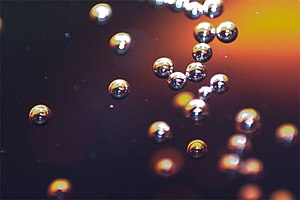Carbonated water
It has been suggested that this article be merged with Soda water. (Discuss) Proposed since April 2010. |

Carbonated water, also known as sparkling water, fizzy water, seltzer, and water with gas, (collectively as an aerated beverage), is plain water into which carbon dioxide gas has been dissolved, and is the major and defining component of most soft drinks. The process of dissolving carbon dioxide gas is called carbonation. It results in the formation of carbonic acid (which has the chemical formula H2CO3).
Carbonated water, also known as soda water, can be produced in the home by "charging" a refillable seltzer bottle by filling it with water and then adding carbon dioxide. Club soda may be identical to plain carbonated water or it may contain a small amount of table salt, sodium citrate, sodium bicarbonate, potassium bicarbonate, potassium citrate, potassium sulfate, or disodium phosphate, depending on the bottler. These additives are included to emulate the slightly salty taste of homemade soda water. The process can also occur naturally to produce carbonated mineral water, such as in Mihalkovo in the Bulgarian Rhodopes, or Medzitlija in Macedonia.
History
In 1767 Englishman Joseph Priestley invented carbonated water when he first discovered a method of infusing water with carbon dioxide when he suspended a bowl of water above a beer vat at a local brewery in Leeds, England.[1] The air blanketing the fermenting beer—called 'fixed air'—was known to kill mice suspended in it. Priestley found water thus treated had a pleasant taste and he offered it to friends as a cool, refreshing drink. In 1772 Priestley published a paper entitled Impregnating Water with Fixed Air in which he describes dripping oil of vitriol (sulfuric acid) onto chalk to produce carbon dioxide gas, and encouraging the gas to dissolve into an agitated bowl of water.[2]
In 1771 Swedish chemistry professor Torbern Bergman independently invented a similar process to make carbonated water. In poor health at the time yet frugal, he was trying to reproduce naturally-effervescent spring waters thought at the time to be beneficial to health.[citation needed]
Ányos Jedlik (1800-1895), a Hungarian, invented consumable soda-water that continues to be a popular drink today. He also built the world's first carbonated water factory in Budapest, Hungary [citation needed]. After this invention, a Hungarian drink made of wine and soda water called "fröccs" (wine spritzers) was spread throughout several countries in Europe.
Since then, carbonated water is made by passing pressurized carbon dioxide through water. The pressure increases the solubility and allows more carbon dioxide to dissolve than would be possible under standard atmospheric pressure. When the bottle is opened, the pressure is released, allowing the gas to come out of the solution, thus forming the characteristic bubbles.
In the United States, carbonated water was commonly known by the name of soda water until World War II. During the Great Depression, it was also referred to as two cents plain, a reference to its place as the cheapest drink available at the soda fountain. In the 1950s new terms such as sparkling water and seltzer water began to be used. The term seltzer water is a genericized trademark that derives from the German town Selters, meaning "water from Selters." [3] where naturally carbonated water has been commercially bottled and shipped into all parts of the world at least since the 18th century.[4]
Flavored carbonated water is also commercially available. It differs from sodas in that it contains flavors (usually sour fruit flavors such as lemon, lime, cherry, orange, or raspberry) but no sweetener.
Health effects
Sparkling mineral water is a negligible cause of dental erosion; also known as acid erosion. While the dissolution potential of sparkling water is greater than still water, levels remain low: by comparison, carbonated soft drinks cause tooth decay at a rate of several hundred times that of regular sparkling water. De-gassing of a sparkling mineral water reduces its dissolution potential, but the total levels are still relatively low, suggesting that carbonation of drinks may not be an important factor in causing dental erosion.[5]
Intake of carbonated beverages has not been associated with increased bone fracture risk in observational studies, and the net effect of carbonated beverage constituents on the amount of calcium in the body is negligible, leaving carbonated water as harmless as regular water.[5]
Recent advertisements by the State of New York encourage citizens to drink water, seltzer and milk instead of sugary beverages. [6]
See also
References
- ^ "Joseph Priestley - Discovery of Oxygen - Invention of Soda Water by Joseph Priestley". Inventors.about.com. 2009-09-16. Retrieved 2009-09-23.
- ^ Priestly, Joseph (1772). "Impregnating Water with Fixed Air, Page 7". Retrieved 2008-08-07.
- ^ "Definition of seltzer - Merriam-Webster Online Dictionary". Retrieved 2007-11-07.
- ^ "History of Selters". Retrieved 2009-07-29.
- ^ a b Parry J, Shaw L, Arnaud MJ, Smith AJ (2001). "Investigation of mineral waters and soft drinks in relation to dental erosion". Journal of oral rehab. 28 (8): 766–72. PMID 11556958.
{{cite journal}}: CS1 maint: multiple names: authors list (link) - ^ http://www.nyc.gov/html/doh/downloads/pdf/pan/PouringOnPounds.pdf
